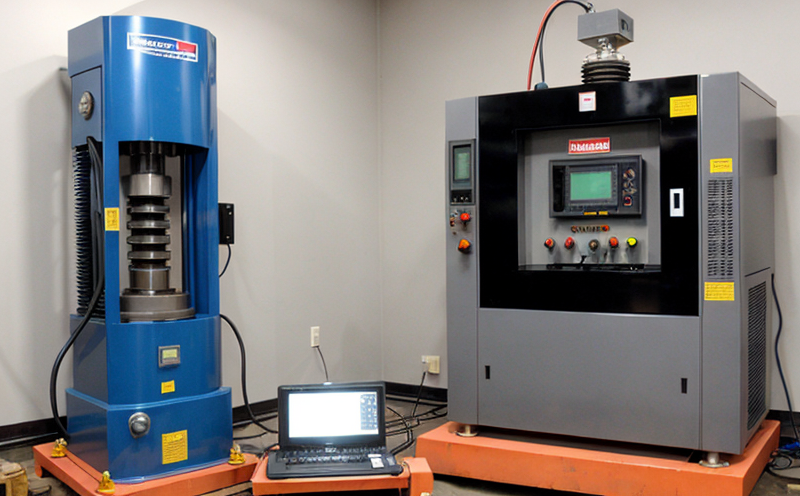ASTM D3332 Mechanical Shock Fragility Testing
The ASTM D3332 mechanical shock fragility testing is a critical procedure used to evaluate how products withstand sudden, intense mechanical shocks. This test is essential for quality managers, compliance officers, R&D engineers, and procurement teams in the electronics sector as it ensures that devices are robust enough to meet real-world conditions without failure.
The test simulates the impact of mechanical shock on electronic components during manufacturing, packaging, transportation, or use. It helps identify potential weaknesses in design, material selection, or construction techniques that could lead to premature failure under stress. The results from this testing contribute significantly to improving product reliability and safety standards.
During ASTM D3332 testing, specimens are subjected to controlled shock events using specialized equipment capable of generating high levels of acceleration within short durations. Specimens can vary widely depending on the type of electronic device being tested but typically include printed circuit boards (PCBs), connectors, integrated circuits, or complete assemblies.
Proper preparation of the specimen is crucial before conducting ASTM D3332 tests. This involves cleaning the sample thoroughly to remove any contaminants that might affect test results. The orientation and positioning of the sample relative to the direction of shock are also important factors affecting accuracy during testing.
The application of mechanical shocks follows specific procedures outlined in ASTM D3332, which specify parameters like peak acceleration levels, duration times, repetition cycles, and environmental conditions such as temperature and humidity. These controlled variables allow for consistent reproduction of realistic shock scenarios encountered by products throughout their lifecycle.
Post-test evaluation focuses on assessing whether the specimen has sustained damage or experienced functional degradation due to applied shocks. Observations include visual inspections for cracks, fractures, warping, or changes in appearance; electrical continuity checks using ohmmeters; and functional testing of critical components or entire assemblies.
| Standard | ASTM D3332-18a |
|---|---|
| Date | February 1, 2018 |
| Description | This standard provides guidelines for performing mechanical shock fragility tests on electronic components and assemblies. It covers various aspects including test setup, specimen preparation, application of shocks, and evaluation methods. |
The results obtained from ASTM D3332 testing provide valuable insights into a product's ability to withstand mechanical shocks without sustaining damage or compromising functionality. By incorporating these tests into the development process, manufacturers can enhance their products' durability, reduce warranty claims, and improve overall customer satisfaction.
Applied Standards
The ASTM D3332 mechanical shock fragility testing strictly adheres to the guidelines provided in ASTM D3332-18a. This standard specifies detailed procedures for conducting mechanical shock tests on electronic components and assemblies. Key aspects covered by this standard include:
- Setup of test apparatus
- Preparation of specimens
- Application methods for generating controlled shocks
- Evaluation criteria for determining pass/fail status based on observed damage or functional performance
The use of ASTM D3332 ensures consistency and reproducibility in testing, which is vital for accurate assessment of a product's mechanical shock resistance.
Customer Impact and Satisfaction
- Better Product Reliability: By identifying weak points early during development or production, customers can implement necessary improvements before releasing products to market. This leads to fewer failures in the field.
- Increased Customer Trust: Showing commitment to rigorous quality assurance measures builds trust among consumers and business partners alike.
- Lower Warranty Costs: Early detection of potential issues reduces long-term costs associated with repairing or replacing defective products.
- Enhanced Reputation: Demonstrating leadership in adhering to industry best practices enhances a company's reputation within the electronics sector.
These factors contribute directly to higher customer satisfaction levels, ultimately driving business success and growth.
International Acceptance and Recognition
- Acknowledged by Leading Standards Bodies: ASTM D3332 is widely recognized globally for its relevance in assessing mechanical shock fragility of electronic components. Its acceptance extends across various countries, including the United States, Canada, Europe, Asia-Pacific regions.
- Use Across Industries: Beyond just electronics manufacturing, this test method finds application in automotive, aerospace, and medical device industries where robustness against shocks is crucial.
The widespread adoption of ASTM D3332 reflects its significance in ensuring product integrity across diverse markets. Compliance with these standards helps manufacturers meet regulatory requirements while maintaining high-quality standards.





